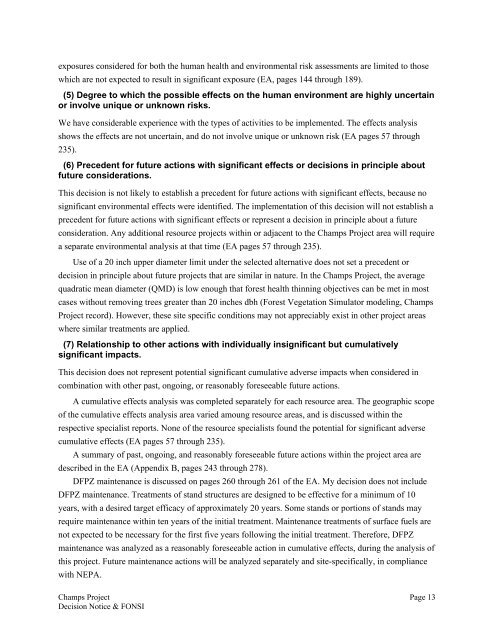Champs Project
Champs Project
Champs Project
Create successful ePaper yourself
Turn your PDF publications into a flip-book with our unique Google optimized e-Paper software.
exposures considered for both the human health and environmental risk assessments are limited to those<br />
which are not expected to result in significant exposure (EA, pages 144 through 189).<br />
(5) Degree to which the possible effects on the human environment are highly uncertain<br />
or involve unique or unknown risks.<br />
We have considerable experience with the types of activities to be implemented. The effects analysis<br />
shows the effects are not uncertain, and do not involve unique or unknown risk (EA pages 57 through<br />
235).<br />
(6) Precedent for future actions with significant effects or decisions in principle about<br />
future considerations.<br />
This decision is not likely to establish a precedent for future actions with significant effects, because no<br />
significant environmental effects were identified. The implementation of this decision will not establish a<br />
precedent for future actions with significant effects or represent a decision in principle about a future<br />
consideration. Any additional resource projects within or adjacent to the <strong>Champs</strong> <strong>Project</strong> area will require<br />
a separate environmental analysis at that time (EA pages 57 through 235).<br />
Use of a 20 inch upper diameter limit under the selected alternative does not set a precedent or<br />
decision in principle about future projects that are similar in nature. In the <strong>Champs</strong> <strong>Project</strong>, the average<br />
quadratic mean diameter (QMD) is low enough that forest health thinning objectives can be met in most<br />
cases without removing trees greater than 20 inches dbh (Forest Vegetation Simulator modeling, <strong>Champs</strong><br />
<strong>Project</strong> record). However, these site specific conditions may not appreciably exist in other project areas<br />
where similar treatments are applied.<br />
(7) Relationship to other actions with individually insignificant but cumulatively<br />
significant impacts.<br />
This decision does not represent potential significant cumulative adverse impacts when considered in<br />
combination with other past, ongoing, or reasonably foreseeable future actions.<br />
A cumulative effects analysis was completed separately for each resource area. The geographic scope<br />
of the cumulative effects analysis area varied amoung resource areas, and is discussed within the<br />
respective specialist reports. None of the resource specialists found the potential for significant adverse<br />
cumulative effects (EA pages 57 through 235).<br />
A summary of past, ongoing, and reasonably foreseeable future actions within the project area are<br />
described in the EA (Appendix B, pages 243 through 278).<br />
DFPZ maintenance is discussed on pages 260 through 261 of the EA. My decision does not include<br />
DFPZ maintenance. Treatments of stand structures are designed to be effective for a minimum of 10<br />
years, with a desired target efficacy of approximately 20 years. Some stands or portions of stands may<br />
require maintenance within ten years of the initial treatment. Maintenance treatments of surface fuels are<br />
not expected to be necessary for the first five years following the initial treatment. Therefore, DFPZ<br />
maintenance was analyzed as a reasonably foreseeable action in cumulative effects, during the analysis of<br />
this project. Future maintenance actions will be analyzed separately and site-specifically, in compliance<br />
with NEPA.<br />
<strong>Champs</strong> <strong>Project</strong> Page 13<br />
Decision Notice & FONSI
















